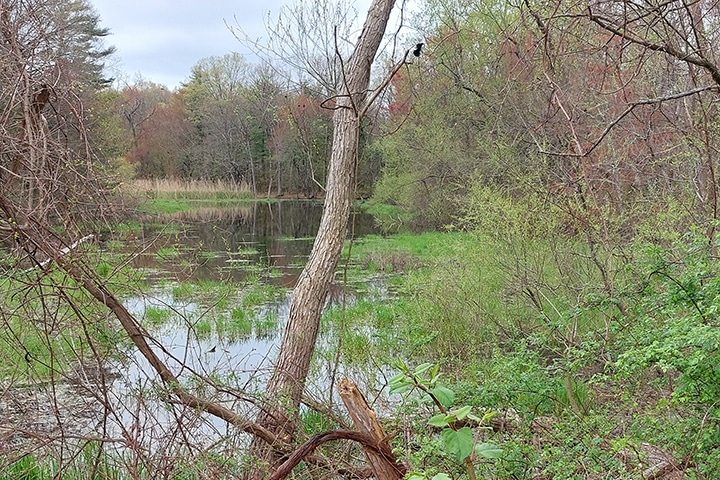The Anna & Joseph Bonavita Memorial Conservation Area, a privately owned pond surrounded by marshland, is directly adjacent to land where a housing development is slated to be constructed.
Reminder Publishing photo by Sarah Heinonen
SPRINGFIELD — Mary Dionne drove down the streets of a neighborhood in the Outer Belt area of Springfield. Pointing as she passed homes on Ellendale Circle, she said, “These houses have water in their basements, I’m sure they do.” She turned onto Parker Street and then Allen Street, heading toward Bicentennial Avenue.
Dionne pulled into Bicentennial Plaza and drove around the businesses to the back of the lot. Just past the parking lot is a marsh area with a large pond of standing water and a sign declaring the privately owned wetland, “The Anna & Joseph Bonavita Memorial Conservation Area.”
The land adjacent to the plaza and pond has been approved by the city for construction of a 13-house subdivision. Less than a mile away, immediately behind the Stop & Shop at the intersection of Allen and Cooley streets, a 17-house subdivision is slated for property that backs up to the houses on Ellendale Circle that Dionne had spoken about.
“I walked back there a couple days ago, and it was a lake,” said Walter Gould. He, Dionne and Ellis Gray are members of the Outer Belt Civic Association who are concerned about how construction projects like these will affect the water levels in this low-lying section of Springfield.
“None of these houses should have been built here,” Dionne said of the subdivisions and neighborhoods that sit off Allen Street, a busy thoroughfare. “There’s water all over here.” Gould agreed and said the residents on Forest Hills Road have groundwater seeping up through their lawns and basements. One neighbor has a sump pump that has been running nonstop for three months to stay ahead of basement flooding, he said.
With the addition of two housing developments, and the asphalt and impervious surfaces that go with them, the three are worried that more water runoff will add to the existing moisture and flooding problems for the people living in the area. Gould said climate change will continue to increase the frequency and severity of storms, resulting in an even higher groundwater level.
Housing is not the only concern the trio have identified. About halfway between the two planned developments, a wooded property behind the Five Town Plaza has been approved as the future site of a solar array. Dionne said the removal of the trees will mean less water absorbtion and more runoff. However, Gould admitted he would rather the land be used for solar panels installed over a grass field than have another housing development with impervious surfaces constructed. “The solar farm is the lesser of two evils,” he said.
“We keep asking, ‘Where is the water going to go?’ And they can’t tell us,” Dionne said.
According to the city, however, the question has been answered. City Planner Philip Dromey said, “All of those projects have been fully reviewed and approved.” The drainage plans for the housing developments have been submitted to the Department of Public Works. The solar field did not trigger a site plan review as it is an as by right use, Dromey explained.
City Engineer Andrew Krar approved the stormwater management plan for the solar field, drafted by the engineering firm Fuss & O’Neill for the developer, NextGrid. He explained, “Engineers come in and they submit all the required reports. We compare what is written and what is calculated in those reports with the standards from [the state Department of Environmental Protection]. There was no unreasonable detrimental impacts that I identified.”
The stormwater management plans for the neighborhood being constructed next to Bicentennial Plaza has also been approved. Of the stormwater plan for the neighborhood being developed near the intersection of Allen and Cooley streets, Krar said, “I take no exception to the plans, as of now.” Krar said the developments have been approved by the city’s Conservation Commission, which is responsible for ensuring construction projects do not encroach upon or otherwise impact wetlands.
Stormwater plans are a requirement of the state regulations and local bylaws when developing land. The city requires developments “maintain the natural hydrologic characteristics of the land in order to reduce flooding, stream bank erosion, siltation, nonpoint source pollution [and] property damage.” Another requirement is that “post-development runoff volume and quality to be equivalent to or an improvement on pre-development runoff conditions.”
Despite the stormwater plans meeting these criteria, Dionne is not convinced. She commented, “Water never goes away. It just finds a place to go.”
Reminder Publishing reached out to NextGrid and Fuss & O’Neill. Neither responded by press time.


